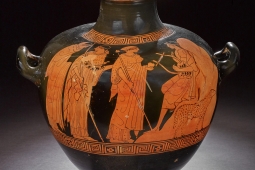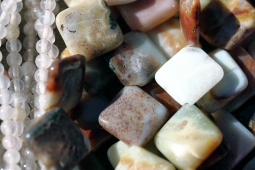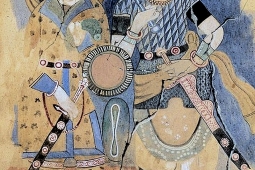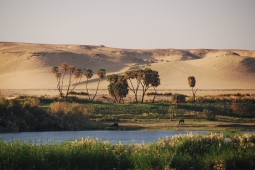Cultural Selection: The Evolution in Forms of Lutes and other Stringed Instruments along the Silk Roads
© UNESCO Youth Eyes on the Silk Roads - Bahram BayatDifferent forms of music and the various instruments used to create it, spread beyond their regions of origin, accompanying people as they moved along the Silk Roads. In turn, those travelling these routes absorbed the different musical influences of the regions they passed through. Indeed, many musical instruments that were common in Silk Roads regions were very flexible and could be used to play a variety of styles of music. String instruments were amongst some of the most popular, versatile, and widespread across Eurasia, and much of the evidence for their transmission across the Silk Roads survives in the form of paintings, reliefs, and statues, which have been used to trace their movement and evolution.
Some of the earliest stringed instruments known were harps and lyres (which resemble small harps), speculated to have been first derived from hunting bow whose strings make a sound as they vibrate. The lyre enjoyed high cultural status in Mesopotamia and the Classical Greek and Roman world where it was associated with ideas of art, love, the human spirit, and interaction with the natural world. Although characteristic of the Mediterranean region the lyre spread far beyond its region of origin and representations of the instrument have been uncovered from sites in the North of the Indian Subcontinent, Bactria, and other Central Asian regions along the Silk Roads.
Another example of a stringed instrument which was widely transmitted and transformed as it spread to new regions along the Silk Roads was the ‘lute’. A lute can refer to any plucked string instrument with a neck, which can be long or short, and a deep round back enclosing a hollow cavity which usually has an opening to allow sound to escape. Typically made from wood, lutes were important instruments in the development of music theory across Eurasia having been used by Pythagoras in the 3rd millennium BCE to codify musical mathematics. Later, Islamic scholars built on this work using the ‘oud’ a similar stringed instrument which was exported back to Europe where it became extremely popular and formed the basis of much Renaissance music. Lutes can be played fretted or unfretted (with the strings ‘open’) and their modern descendants include instruments such as violins, guitars, mandolins, and banjos.
From its origins in the classical world the lute spread across Eurasia and parts of Africa, changing in small ways at it transfused, evolving incrementally into new types of string instruments, and taking on different cultural associations. There were three main variants of stringed instrument which spread across Eurasia along with the movement of people across the Silk Roads, the traditional lute, the ‘ovoid’ lute, and the ‘pipa’. In the earliest surviving depictions of lutes, which come from Mesopotamian terracotta, they are depicted as long necked instruments, with small drum-like bodies, and are always played by men. However, when the lute was introduced to Egypt around 1500 BCE it appears to have become an instrument played predominantly by women and this change remained when the instrument was re-imported into Central Asia. Furthermore, depictions of lutes contained within sculpture from Sogdiana, Bactria, and Gandhara dating from the Kushan period (30 – 375 CE) frequently depict women playing the lute, often in a religious context and incorporating images of, or symbols associated with, the Bactrian goddess Nana. Nana is frequently depicted with a horizontal crescent the shape of which is reflected in the sound holes of the short necked Central Asian lutes. These same crescent shapes are present in depictions of lutes at Buddhist rock cut caves such as those at Ajanta and Amaravati. However, the instrument later disappeared from the iconography of the Indian Subcontinent and was not reintroduced until around the 12th century CE.
Similarly, the ‘ovoid’ or oval shaped lute moved across Central Asia and was introduced to China where it became known as the ‘pipa’. From China it spread to Vietnam, the Korean Peninsula and Japan. However, within these new contexts the instrument remained strongly associated with Central Asia, particularly in Tang China (618 – 907 CE). Additionally, there are also numerous examples of these instruments, which were made from expensive sandal wood and could be exquisitely decorated with mother of pearl, being presented as diplomatic gifts. The ovoid lute was also introduced to the Iranian Plateau, and later the Islamic world, where it was known as the ‘barbat’.
Another popular Eurasian stringed instrument was the ‘zither’ which has a box shaped body with strings stretched across it that can be played ‘open’ or ‘stopped’ at various points to change the pitch of the sound produced. However, unlike other types of lute, the zither is an example of independent invention, in that it does not appear to have been spread across different regions via travel and trade but was instead independently invented and popularised in several different regions at once. Despite this there were many different types of zither which all share a set of similar core characteristics, including bamboo zithers in Southeast Asia, the ‘santur’ and ‘psaltery’ box zithers to the West, the elongated Chinese zithers and the ‘ginq’ a type of zither that evolved from Central Asian harps.
The exact nature in which many different string instruments spread across Eurasia and evolved to take on new characteristics was undoubtedly a highly complex process. What remains evident however, is that as these instruments travelled, they were adapted to suit the new contexts in which they were played in an exchange of elements that remains apparent in the forms and playing styles of stringed instruments in the contemporary world.
See Also

Cross-Cultural Influences Reflected in a Bactrian Ewer Depicting Scenes from Ancient Greek Mythology
Sometimes practical and sometimes a piece of decorative art, ewers are tall thin vessels with a wide base, spout, and handle that have been uncovered from numerous archaeological sites from along the lengths of the Silk Roads.







